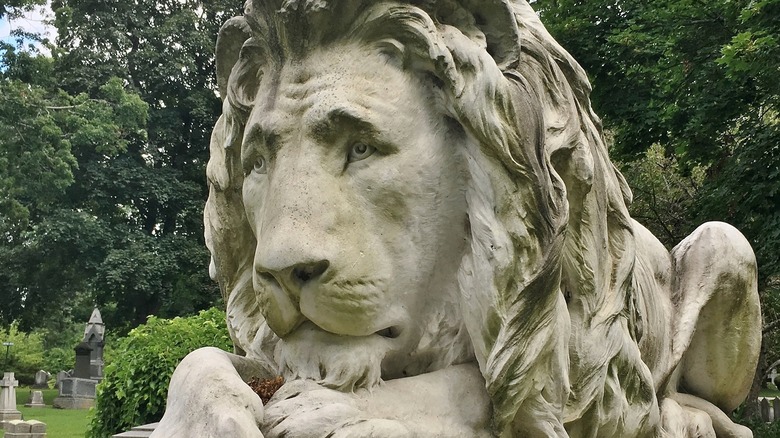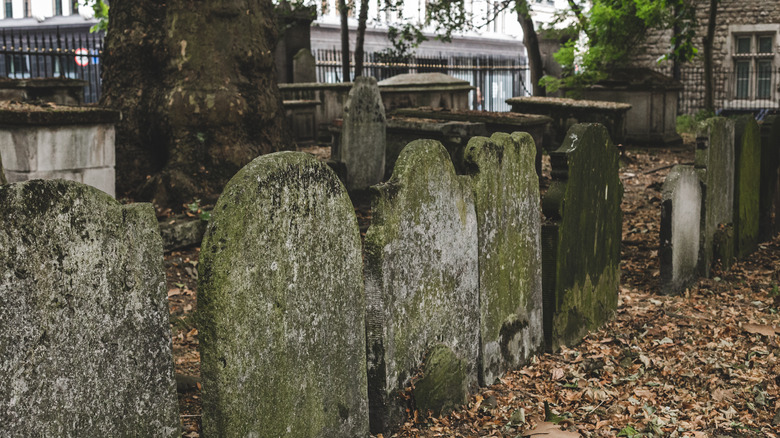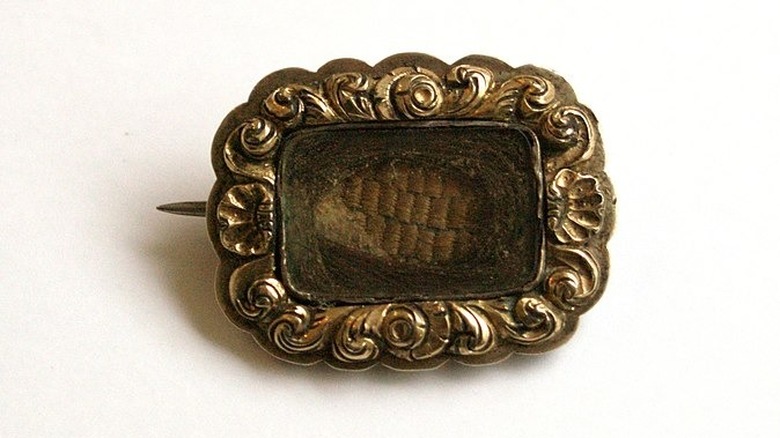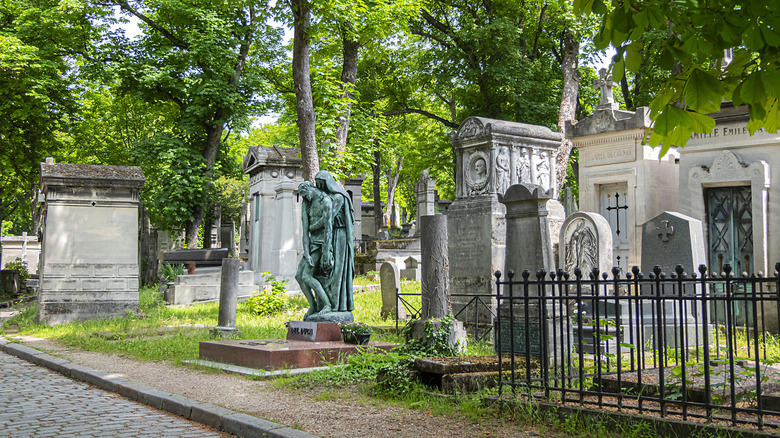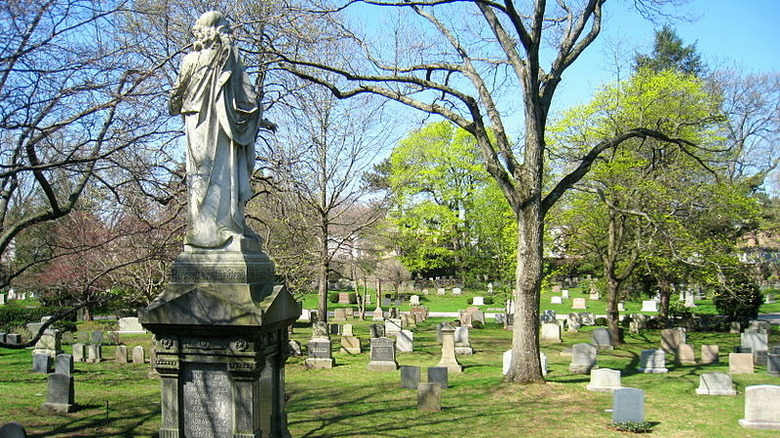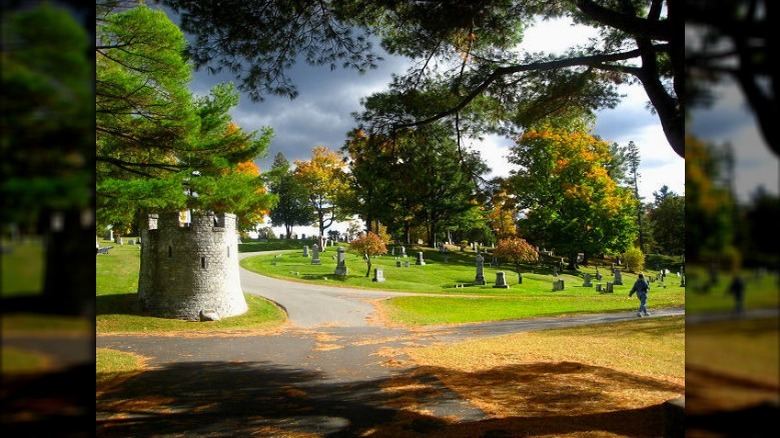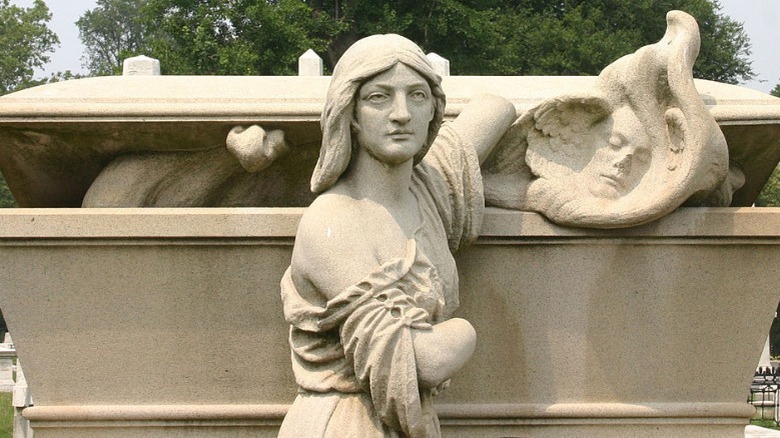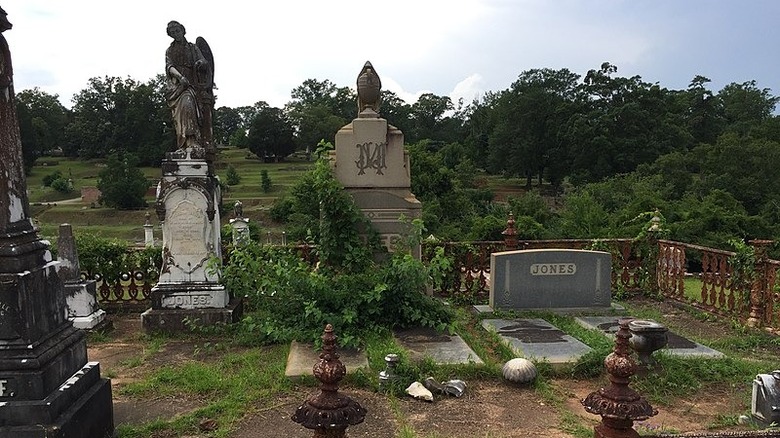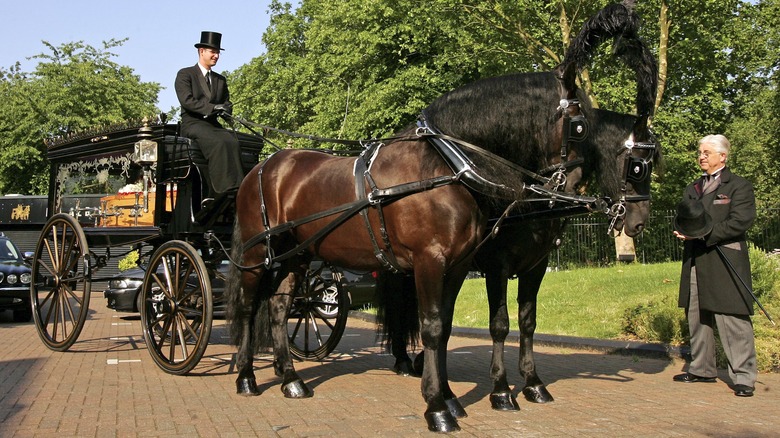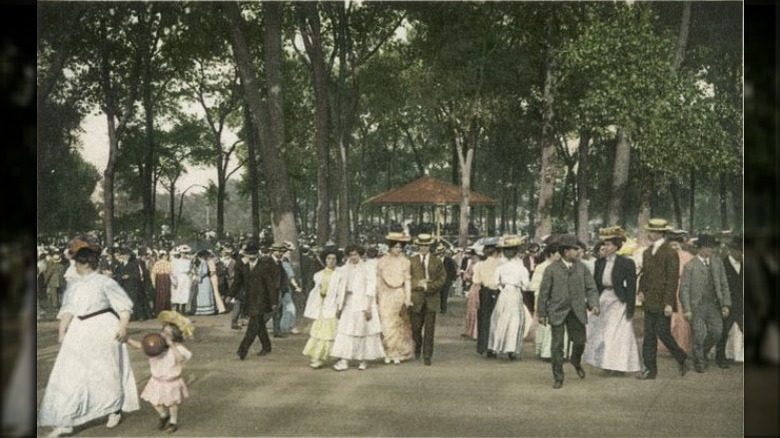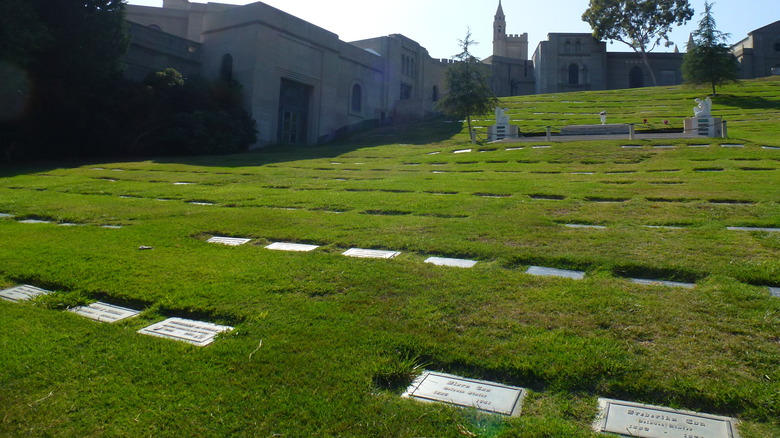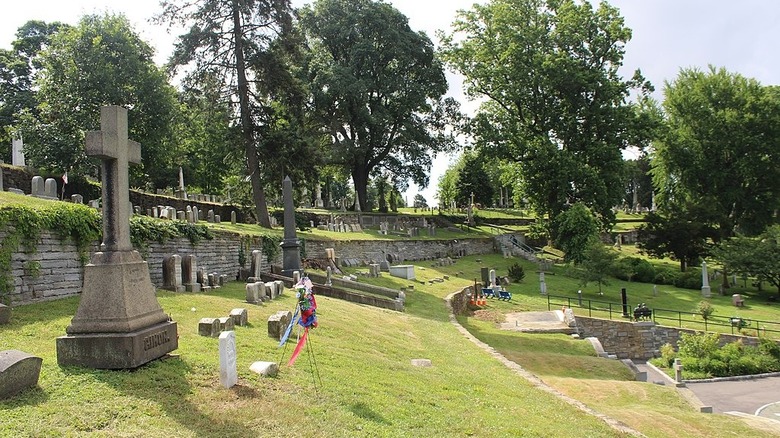The Weird History Of The Garden Cemetery Movement
Everything goes through changes over the years. We know that throughout history, ideas about what's right and proper changes, what's cool changes, and people's wants and needs change. But when it comes to death, how much could that really change? Surely, it can't be much more complicated than taking a dead body and putting it in the ground. How could that possibly be a fad that goes in and out of style?
Well, as it turns out, people who are still lucky enough to be alive have lots of thoughts about what is fashionable in the world of burial. It wasn't that long ago when the only acceptable place to be buried for a Christian living in the Western world was a graveyard attached to a church. But eventually, logistics and changing ideas about death meant that people were buried in locations unaffiliated with any religious institution that didn't even look like graveyards. They looked more like ... parks. Or if you want to be fancy, gardens.
The Victorian era put its stamp on death, and that includes the way they buried their loved ones. This is the weird history of garden cemeteries.
By the 1800s, urban graveyards were overcrowded and deadly
It's important to understand the difference between a graveyard and a cemetery especially because, as The Atlantic explains, prior to 1831, "America had no cemeteries." That didn't mean they left dead bodies lying around, though. It just meant that when someone died, at least if they were Christian, which most of America was, they were buried in a small graveyard attached to a church. That church would often be in the center of the town or city. And there could be multiple churches with multiple graveyards. But it still wasn't enough room by the early 1800s.
As centrally located graveyards filled up with decade upon decade of the new country's dead, according to Atlas Obscura, they started "literally overflowing." The conservation group American Forests says that heavy rain would flood the graveyards, and while they go with the euphemism that there were "gruesome results," they mean bodies could rise to the surface. But it wasn't just morbid — it could be deadly. Water supplies would be contaminated, leading to epidemics of scary diseases like cholera and typhoid.
It wasn't just the health issues, either. Graveyards were places where ne'er-do-wells hung out. This was the era of the body snatchers, and strangely, graveyards were considered the perfect place for those engaging in gambling and sex work. Plus, as cities grew, land became more valuable, and all these dead people were taking up perfectly good real estate. Something had to be done.
The Victorians were changing attitudes to death
A huge societal shift was happening in the early 1800s as well. According to Atlas Obscura, before the Victorian era, people in the U.S. and much of Europe saw death as something bad and scary that you needed to be reminded about so the reality of it would terrify you enough to be a good person while you still had the time. But the Romantic movement (think Lord Byron) started to make death into a sexy thing, or at least something that you could reflect on in a beautiful way.
You have to remember that, in Victorian times, people were dying left and right. This was before most vaccines, not everyone had access to clean water, and even basic, competent medical care was hard to find. More likely than not, you'd lose siblings, parents, children, and any number of extended family or friends in your lifetime. And far sooner than we do today. With death such an ever-constant presence, it's no wonder that people wanted to make it a little less traumatizing.
As the Australian Museum explains, the Victorians took death and the act of mourning and turned it into something fashionable. Wearing the right clothes and jewelry and for the right amount of time depending on how close you were to the deceased, planning an elaborate funeral for yourself before you died, and taking pictures of the dead became the norm. Dingy old graveyards would no longer do for this new death lifestyle.
Père Lachaise influenced all other garden cemeteries
Paris was one of the biggest cities in the world in the 18th century, which meant it had an exceptional amount of dead people. Overflow became a problem there a bit before it did in places like the U.S., so in 1799, Napoleon held a contest to design a new burial ground that would take care of the body problem.
According to City of Immortals, the winner was a design that was more like a garden than a cemetery. The final product was outside the city on rolling hills with trees, paths, and sculptures. While it took a little while (and some celebrity corpses) for the Parisians to come around to Père Lachaise, once they did, they never looked back.
To say people liked this new, gorgeous cemetery is an understatement. The Journal of Garden History records that Père Lachaise became an iconic Paris landmark almost immediately. For visitors to the City of Lights, a tour of the burial ground was often the first item on their agenda. Some of them must have thought how nice it would be to be buried in a place like that and wondered why their hometown couldn't have a cemetery that was more like a garden filled with art. So, as the Journal explains, "the Cemetery of Père Lachaise became the point of reference for establishing new cemeteries in the Anglo-Saxon world." Encyclopedia.com calls Père Lachaise's influence on cemetery design in the 19th century "nothing short of a revolution."
Mount Auburn Cemetery: The first garden cemetery in America
Boston was having the same graveyard problems as the rest of America's big cities, but they were the first ones to figure out what to do about it. It was actually the Massachusetts Horticultural Society who came forward with a plan, so it's no surprise that the concentration of this new cemetery was going to be on plants and landscape design, with paths and views and the feel of a European garden.
Encyclopedia.com calls their design "radical" because "this new gravescape would be a place from which the living would be able to derive pleasure, emotional satisfaction, and instruction on how best to live life in harmony with art and nature." This was never meant to be just a place to bury the dead, and it met and hugely surpassed those expectations. American Forests says Mount Auburn Cemetery "grew into a feat of landscape design, sculpture and meticulously manicured Victorian-style gardens." The Wilson Center quotes the cemetery's contemporary Fanny Kemble, who called it "a pleasure garden instead of a place for graves," and, with the highest compliment you can give a burial ground, said it "almost excites a wish to die." Many others felt just like her: According to Project for Public Spaces, Mount Auburn "quickly [gained] status as a sought-after final burial place through the 1830s."
With reviews like these, it's no wonder that other cities wanted their own version of Mount Auburn Cemetery. The garden cemetery movement in America was underway.
Garden cemeteries were the first public parks
The whole point of garden cemeteries, besides making cities more sanitary, was to be beautiful, relaxing places. Sure, that might make it nicer to attend a funeral, but you know what else is fun to do on wide, rolling hills filled with sculptures and trees and beautiful views? Literally anything else. So decades before Central Park set the standard for urban green spaces, garden cemeteries became the first public parks.
Because the garden cemeteries were located some distance outside of cities or towns, going to one would become an entire day out, according to Atlas Obscura. The Center for Research Libraries says that families would often go to the cemeteries on Sundays for picnics. Laying out a blanket some distance from the graves and having a quiet lunch might not sound too disrespectful, but it hardly stopped there. Far from it. Per the Atlantic, people would come to the cemeteries to hunt, shoot, and even hold carriage races. (While a cemetery might be the ideal place to be if you're going to have a shooting accident, one at least hopes that the carriage races took place far from the graves.)
It wasn't just slightly morbid weirdos who showed up, either: Garden cemeteries were such popular locations that they had their own guidebooks, and rules had to be posted to make sure all the people enjoying themselves didn't interfere with the actual funerals. Green-Wood Cemetery in Brooklyn had so many visitors in the 1860s, it almost beat out Niagara Falls as the top tourist site in the U.S.
Garden cemeteries as art museums
If crowded inner-city graveyards didn't have room for the number of bodies buried there, they certainly didn't have room for many elaborate headstones or monuments. But the wide-open spaces of garden cemeteries changed all that. Suddenly, a rich man or war hero could have a tombstone of the size and shape that he felt reflected his greatness.
Père Lachaise immediately went all-in with the over-the-top monuments. Atlas Obscura says the designers there "[shrugged] austerity for romantic, dramatic sculptures," immediately drawing just as many tourists to see them as actual mourners. Laurel Hill Cemetery in Philadelphia was a preferred burial spot for war heroes, and their graves were often marked by life-size sculptures of the deceased. According to the Wilson Center, even those with less money or fame still got much fancier headstones than they would have in a church graveyard. Instead of bland slabs with their name and dates on it, they would now be decorated with religious symbols, a family crest or sigil, or other designs illustrating something important about their life or death.
At a time before many public art museums existed in the world, these elaborate grave markers essentially became a free open-air gallery for the average man or woman. And these monuments really were proper art: The Pennsylvania Historical & Museum Commission writes that these monuments were designed by "the finest architects" and that "the elaborate sculptures achieved by the stone craftsmen of the day are unparalleled in any subsequent cemeteries."
The beginning of family plots in garden cemeteries
Some families like sticking together through thick and thin, and you can't get any thicker (or, wait, is it thinner? Which one is the bad one?) than death. For those relatives who wanted to spend eternity within a few feet of each other, even if they could barely get through Christmas Day together while alive, old-school graveyards didn't really have a good option. Sure, if you were extremely important or wealthy, you might manage to get generations of your family together in a vault or section of a churchyard, but your average person had to hope there was room for just their small grave, let alone family members who weren't going to die for decades or maybe weren't even born yet.
Garden cemeteries meant large family plots were suddenly possible for everyone. Well, a lot more people, anyway. Woodland Cemetery History says that families would buy a decently large plot, and that was their land, forever. They treated it like any other property they owned. And when they died, ownership of the land passed to their kids. In death, they not only stayed together as a family, but they could also make a statement about their clan. Many plots were fenced off, as if they were exclusive for the family. There might be a monument or obelisk with the names of everyone buried there, or just the family's last name.
Garden cemeteries helped turn funerals into a business
Before the Victorian era, funerals were intimately personal events. People usually died at home, their bodies were prepared for burial at home by family members, and the funeral would take place at home before moving to the graveyard. But the emergence of garden cemeteries kick-started the business of death. The logistics of funerals became more complicated, some out of necessity and some out of style, and once your neighbors started doing bigger, fancier funerals, you had to keep up with the Joneses.
Case Western Reserve University's Encyclopedia of Cleveland History explains that carpenters and furniture makers were often called on in the early 19th century to make coffins for people who died. But by the mid-1850s, "undertaking was on the brink of becoming a stand-alone business." Carpenters who made coffins started being called on to deal with other aspects of the funeral, which logically led to some of them concentrating just on funerals. The Civil War necessitated lots of coffins and lots of embalming, which meant more people moved into the booming undertaking field.
FuneralWise notes that as more people were buried in communal garden cemeteries (instead of in local churchyards or on their own property) undertakers stepped in to take the responsibilities off the families of the deceased. Home Funeral Alliance records that in cities especially, details like the coffin and transportation of the body were outsourced to undertakers.
Public parks were the downfall of the garden cemetery
Eventually, city planners realized you could get all the benefits of a garden cemetery without the inconvenience of all the dead people. What if there was a wide, green open space where everyone could go for free and have picnics and chariot races and not trip over any gravestones or be reminded of the futility of life? And since you wouldn't have to worry about health code violations, these gardens-without-the-cemeteries could be in the middle of cities and towns, meaning you wouldn't have to travel as far to get there.
It was the popularity of garden cemeteries that doomed them in the end. The Center for Research Libraries says the design of garden cemeteries became "the foundation of the American park movement." According to American Forests, people like landscape architect Andrew Jackson Downing, who was pushing hard for a park in the middle of Manhattan, borrowed heavily from garden cemetery designs for these new parks. And once cities and towns had parks of their own, including Central Park in New York City, there didn't seem to be as much point of going to the garden cemeteries. That basically just left mourners as the people who used these sites. Suddenly, these cemeteries were no longer vibrant places for the living as well as the dead, they were just ... a burial ground. Public parks took everything other than death away from garden cemeteries, which completely changed how people felt about them.
Many garden cemeteries fell into disrepair
As public parks became the norm, garden cemeteries saw their number of visitors plummet. The emergence of botanical gardens and public art museums meant there was even less reason to go to a rural cemetery, unless you were actually there for a funeral. They became associated only with death, which, to be fair, is what they were made for, but it would also doom them to decades of neglect. The Daily World says these amazing garden cemeteries were "often left abandoned" and "untended."
One of the reasons people stopped caring for garden cemeteries is that our ideas about death changed. For the Victorians, death was everywhere. But in the early 20th century, death rates, especially infant mortality, dropped a lot. This was a great thing for all those people who were still alive, but it meant death became something you could pretend didn't exist.
The Atlantic talked to a professor of art and architecture and expert on cemeteries, Keith Eggener, who explained that even the terminology around where we bury our dead changed. In the U.S. in the 20th and 21st centuries, people created "memorial parks." And these places were flat, inconspicuous, and lifeless, literally. It was part of society's new attempt to ignore death at all costs. Eggener laments, "You don't go out to the memorial park very often ... We send our old people off to homes and hospitals to die; we only go to the cemetery for funerals and then avoid them."
Garden cemeteries are seeing a resurgence
These old garden cemeteries are still around today. There's probably one near where you live, if you're in the United States or parts of Europe. Their current conditions range dramatically, from ones in complete disrepair to those that are still burying people today. Now, many are getting a new lease on life, as it were, as places for recreation, just as the Victorians intended.
These rural cemeteries might have been located outside the town at the time, but as populations boomed and urban sprawl expanded those towns, these cemeteries ended up right in the middle of things. As the Project for Public Spaces explains, in many towns or cities, an old garden cemetery might be the best and largest green space available. And it's not seen as acceptable to just tear the place up and make it something else, since people did technically pay to stay there forever.
In order to make use of the perfectly good space, and pay for the cemeteries' upkeep, many have started hosting a wide variety of events in between the graves. The Philadelphia Inquirer reports cemeteries in that city are hosting "outdoor movies, group dog walks, stargazing, yoga," as well as concerts, Easter egg hunts, and nature walks. In New York City, Green-Wood Cemetery puts on events including "birding classes, workshops on condolence letter writing, and Victorian-style circuses with fire eaters and contortionists." No matter what hobby you are interested in, you can probably do it in your local garden cemetery.
